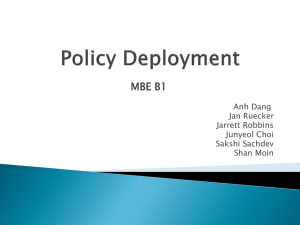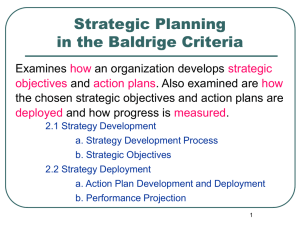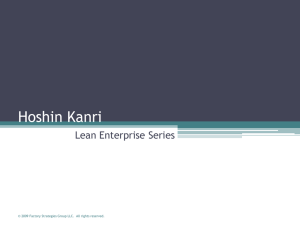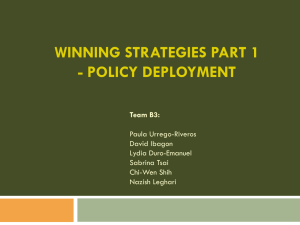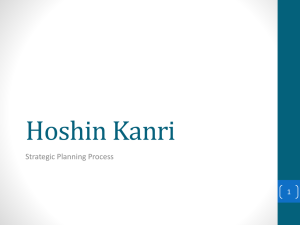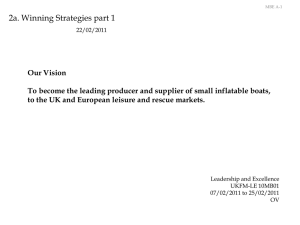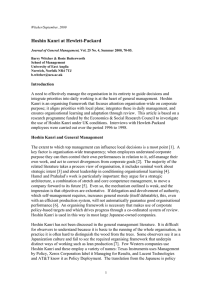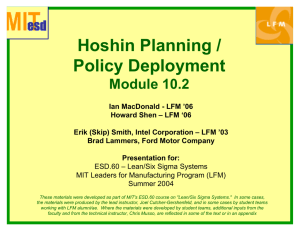WINNING STRATEGIES
advertisement
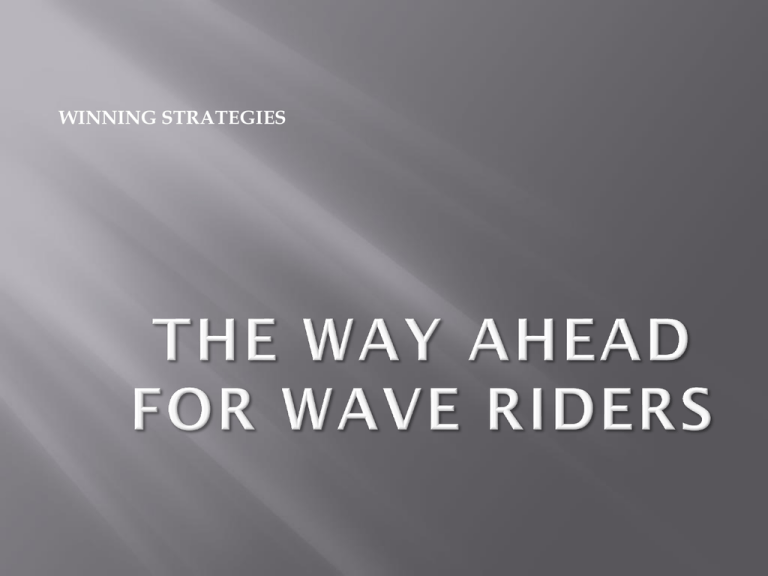
WINNING STRATEGIES The Present – Financials The Present – Sales & Stocks Market Report Chosen Strategy Hoshni Kanri Catch Ball Vision Wave riders’ vision Vital Goals Five year plan Short term departmental Goals 9000 8000 700 7000 600 614 552 494 6000 500 5000 400 330 4000 300 3000 200 2000 180 100 1000 0 2007 2008 2009 2010 2011 Annual Turnover 0 2007 2008 2009 2010 2011 Profit After Taxes 1764 1800 1600 1170 1100 1200 1060 1400 1000 1000 1283 970 1200 800 1000 600 400 1482 Leisure 381 368 1063 852 800 Miltary 350 321 326 200 600 400 0 200 1 2 3 4 5 Sales Figures (units) 0 1 2 3 4 5 Value of FG Inventory Major competitors – Surf ZA & Hagen Leisure market to continue to grow at 6 – 7 % Demand for military goods continues to be stagnant. Funding for Military sector could reduce further. Stricter standards for safety. 90 – 95 % sales of Wave Riders is in the U.K. Wave riders sales (last year) in UK were only 11 % of the total market. Increase market share in Europe Hoshin Kanri is an organising framework for strategic management, which is concerned with the following four primary tasks. To provide a focus on corporate direction by setting annually, a few strategic priorities; to align the strategic priorities with local plans and programmes; to integrate the strategic priorities with daily management; to provide a structured review of the progress of the strategic priorities. (Roberts, 2001) Hoshin Kanri is a systematic method for focusing the activities of an organization on critical breakthrough areas. These may he hard old problems or newly surfaced ones, or they may simply be areas critically in need of improvement (Munshi, 1991) Mission Vision Corp. Philosophy Medium Range Plan Annual Plan / Goals Deployment Implementation Plan Act Regular progress review – Monthly + Quarterly Annual Review PDCA Do Check (Jolayemi, 2008) “Catch ball”, is used to gain consensus on the deployment of Hoshin targets and measures, in a team environment known as “cross-functional management”. (Roberts, 2001) Catchball refers to relative up, down, and horizontal discussions and joint analysis necessary for effective determinations of objectives, strategies, targets and means. (Jolayemi, 2008) Director Function A Department Department Function B Function C Department (Jolayemi, 2008) Describes the ‘shape’ of the future business Sets specific goals Drives strategy (Wilson, 1992) To be the leader in the European market and strive for the delight of all stake holder’s . Global – We deliver what you want where you want and when you want Strives – move on the path of continual improvement Stake holder’s – customer, share holders, employees and society Delight – deliver more than the expectations Goal 1: Goal 2: Goal 3: Goal 4: Goal 5: Meet financial targets To Exceed the customers expectations in quality and service. Deliver 100% on time all across Europe. To be a Carbon neutral, Toxic neutral company. To train and develop all employees to achieve their potential. Goal Today 2013 2014 2015 2016 2017 Goal 1 PBDIT - 423 PBDIT - 600 PBDIT - 800 PDIT - 1530 Goal 2 2 -3 complaints per annum Zero complaint. Zero complaint Zero Complaint Goal 3 On time deliveries 60 % 75 % 90 % 100 % Goal 4 Meeting the statutory requirements Reduce energy consumption 10% Further 10 % 30 % (in five years) Goal 5 No review process in place Start Performance management Financial (Goal 1) Marketing To increase sales by 10 % next year To set up a new marketing team for aggressive marketing in Europe. Strengthen the existing sales team through training and developing on their competencies. Financial (Goal 1) Production Reduction in process cost by 10 % in year 2013 Revisit the SOP and improve upon the production process. Reduce all forms of waste (go Lean). On time delivery (goal 3) Production To reduce the process time from 8 weeks to 6 weeks within a year. Making use of six sigma system and striving for six sigma levels over a period of 3 years process improvement. Reduction of waste (Lean Practices) Jolayemi, J. K. (2008). Hoshin kanri and hoshin process: A review and literature survey. Total Quality Management & Business Excellence , 295 320. Mary Klemm, S. S. (1991). Mission Statements : Selling Corporate values to Employees. Long range planning , 24, 73 - 78. Munshi, G. R. (1991). Hoshin Kanri: a systematic approach to breakthrough improvement. Total Quality Management , 213 - 226. Roberts, C. T. (2001). Hoshin Kanri: Implementing the catch ball process. Long Range Planning , 287 - 308. Wilson, I. (1992). Releasing the power of strategic vision. Long Range Planning , 25, 18 - 28. Thank you
